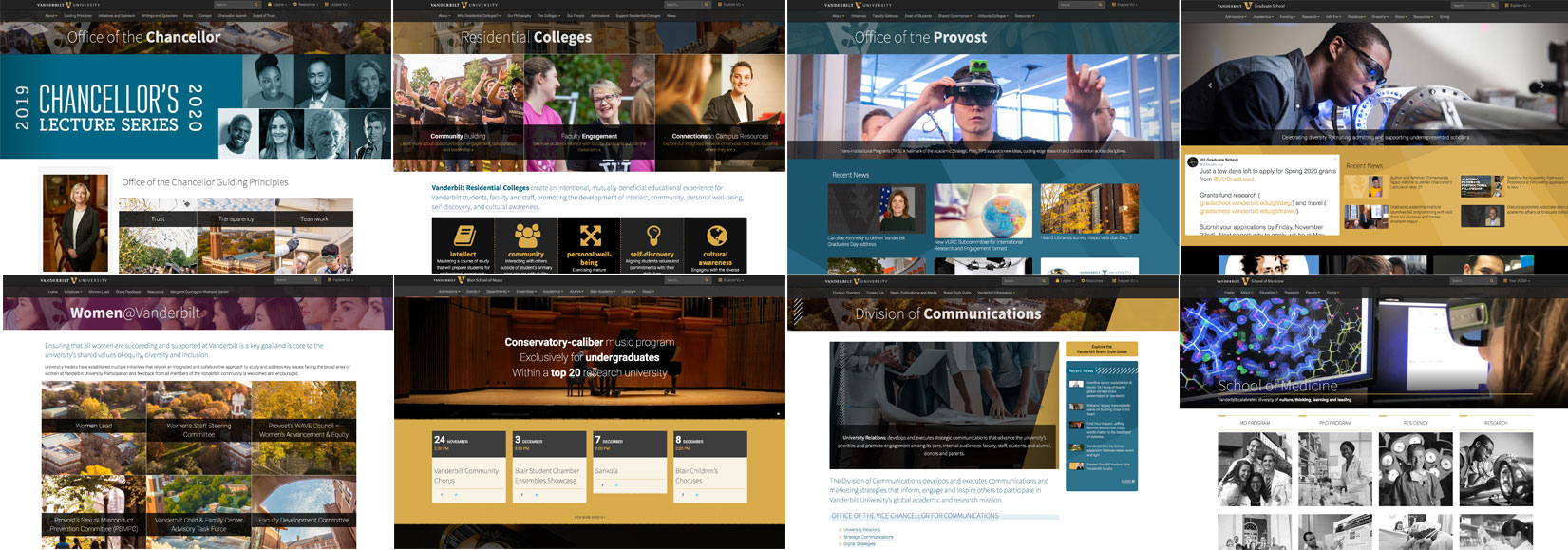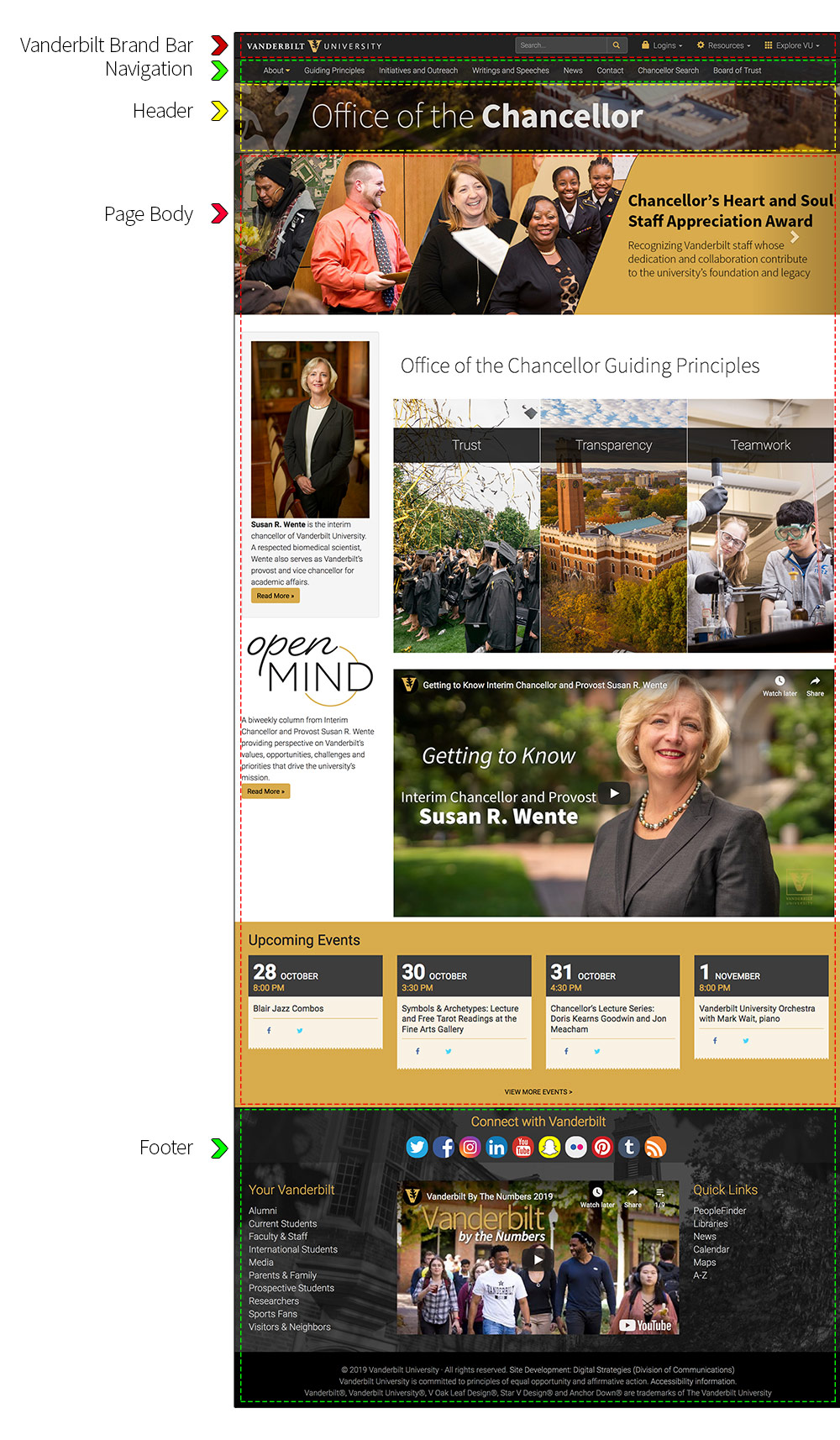Web and Digital
As the primary information gateway to and about the university, the Vanderbilt website is critical in extending and enforcing the university brand in online spaces. Vanderbilt’s web style guide exists to facilitate consistency and usability and to promote standardized university branding across websites university-wide.
Why?
Identity: University branding allows visitors to recognize immediately a webpage’s affiliation with Vanderbilt University.
Usability: Sites must be made as usable and accessible (that is, quick and easy to use, navigate and understand) as possible for the widest audience.
Consistency: Consistency simplifies navigation of pages for end users of Vanderbilt’s webpages. Vanderbilt is committed to maintaining a high level of consistency across webpages in different areas of the university’s website.
Accuracy: Pages must be accurate and up to date.
What Is in Scope?
Any website or document that represents Vanderbilt University or its official units, programs, departments, labs or schools is expected to follow the web style guide.
Vanderbilt’s Web Theme
Vanderbilt has a web theme that is in use across all of its web properties (the theme is the same regardless of the content management system used for your site, WordPress or OmniUpdate).
This theme ensures we can provide a branded, consistent, streamlined and accessible experience for all users.

Global Website Design Standards
 All Vanderbilt University websites must use the following global elements
All Vanderbilt University websites must use the following global elements
which cannot be modified:
Vanderbilt Brand Bar
This section comprises the college/
school-specific or university logo and a search field. It may also include login links and resources.
College/School or University Logo
The logo orients users to where they are in the Vanderbilt University system and provides a link back to the main college/school or university home page.
Search Field
The search field of the Vanderbilt brand bar allows users to search the content of all Vanderbilt websites. College/school and other high-level area brand bars search only a collection of related sites.
ExploreVU
The ExploreVU dropdown links to frequently accessed areas and initiatives of the university.
Logins
The Logins dropdown allows users to connect to applications such as email, BrightSpace, SkyVU and other frequently accessed areas. Generally, this feature is found only on the main Vanderbilt brand bar, not college/school-level sites.
Resources
The Resources dropdown provides quick links to areas such as the calendar, the A-Z guide, university news, and the campus map. Generally, this feature is found only on the main Vanderbilt brand bar, not college/school-level sites.
Navigation
The position, height and width, behavior, colors, and fonts used for the main navigation bar, its dropdown menus, and any subpages’ section navigation cannot be altered. If a dropdown menu is used, the top-level navigation item will only open the dropdown; it will not be a clickable link so that the site will meet accessibility requirements and remain functional on mobile devices.
Header
The position, height and width, behavior and fonts used for the header bar cannot be altered. This assures compliance with accessibility and brand standards. The background image or color used in the header bar can be changed from one site to another but not from one page to another. Background images and colors must meet accessibility requirements.
Footer
The position, height and width, behavior, colors, fonts, and elements found in the footer cannot be altered; however, the content may be customized as follows:
- Connect can be customized to show an individual area’s social media feeds. This area can also be hidden.
- Your Vanderbilt/Quicklinks are the default link lists shown. Both can be customized and renamed as needed.
- The YouTube video area can be swapped for a university-related video of the user’s choice. It can also be replaced with a Google map, a Twitter feed embed, or other custom options.
Page Content Styles
Standard layout options for all pages that make up a site’s content are available for site editors to choose from. Examples of page style options can be reviewed on our style refresh page and may be useful when thinking through the content for a page.
Pages can be laid out in one-, two- or three-column styles. Each column is styled to meet Vanderbilt’s website brand standards. That includes font family, font size, font color, formatting, spacing, and background colors. Alterations to these standards are not allowed, and the university is in the process of bringing all sites into compliance with these standards.
Sites for colleges/schools and other high-level areas have some flexibility with design, but they must adhere to the same brand standards as all other Vanderbilt sites.
Digital Content Strategy
The goal of content strategy is to figure out what you want to say in the simplest possible way. Don’t overcomplicate the process – your main goal for the site should be obvious and easy to understand. The top-level questions you should ask yourself before beginning any page are:
- What is the purpose and goal of this site/page?
- Whom do you want to visit it?
- What should they do/know before leaving?
Once you have basic answers for these three questions you can begin delving deeper into them to structure your content. You don’t want to overwhelm your audience, so at this point you should be liberal with excising content that is overly complex or not related to the top-level questions.
You should ask yourself these questions for every new page on your site. Some pages will be self-explanatory and will not require as much deep work (e.g., a “Contact Us” page), while others may require more in-depth discussion.
One practical way of organizing content is a Word document with an outline structure for your site map. Don’t start writing anything until you have the structure of the site completely worked out.
Some questions you should ask yourself at this stage:
What is the PUrPOSE AND GOAL?
(Some combinations of the examples below are fine, but you should not be trying to do all of these at once on every page.)
- Provide your unique information for this page
- Display media (video/photos)
- Share news
- Give contact or directional information
- Encourage visitors to take action (register for something, request information, etc.)
- Other things we haven’t thought of – this category is malleable!
Whom do you want to visit it?
(You can refer to Google Analytics for help with these questions. If you do not currently have access, please fill out a Help Desk ticket.)
- Who is your intended audience? Students, parents, faculty, staff, alumni, external media, peer institutions, etc.
- Is your intended audience your current audience? If not, how do you plan to reach your intended audience?
- How are people locating this particular page? Read our Google Analytics primer for more information about accessing and understanding your analytics.
- Does the point of your page match your intended audience? If not, reevaluate.
What should your visitors do before leaving?
- This will be different for every page. Some pages (purely informational, for example) may not have a task associated with them. But if you want your interaction with your visitor to continue, there may be additional steps.
- Examples include: find related information (you can tag content so that “related content” pops up); subscribe or sign up (you can accomplish this with forms, links to e-newsletters, etc.); share content on social media; click additional links that send them elsewhere; apply (undergraduate or graduate program applications); donate money or volunteer time.
Does this information need to be on your website?
- Does this information exist elsewhere? If so, link to it. Avoid duplicating information; this way, you’ll always have the most up-to-date information possible. This also keeps the responsibility for the accuracy of the information with the content owner (e.g., deadlines for applications, faculty profile information, list of nearby hotels, etc.).
- Should this information be public? Don’t use your website as your departmental file repository. If you need to share documents, explore using a shared drive or cloud services like Google Docs.
- Do you have a lot of PDFs or Word docs? Consider making those regular webpages, so that search engines can find them.
These goals should be easily manageable and sustainable for your office. This can be accomplished by focusing on a specific and clear goal that is measurable.
Vanderbilt’s Academic Strategic Plan
A good starting place for organizing your content is the Vanderbilt Academic Strategic Plan, which is guided by the following goals:
- to pursue excellence in education by offering experiences that merge the advantages of a liberal arts college with those of a world-class research university;
- to pursue excellence in scholarship, creative expression and research that address important problems and questions facing our community, our country and the world;
- to leverage the many synergies between discovery, learning and service across our entire community of scholars and learners to seek accomplishment and seize opportunities;
- to be transparent and accountable to all the university’s constituencies;
- in sum, to be among the very best research universities in the world.
For more on the strategic plan, please visit the Academic Strategic Plan website.
Next Steps
Once you have your basic site map and strategy set, you can start thinking about the details. This includes layout, colors, graphics and the actual written content of the site. We can assist with and/or consult on many of these elements.
Please refer to the
Vanderbilt Editorial Style Guide
for information on content and style. It is updated regularly.
Promoting Your Site
Congratulations, you have a perfectly curated, easy to understand and navigate website. Now what? Tell the world, or at least your intended audience. This can be done through a myriad of channels; you must decide internally which ones are right for you. Options include:
- social media (see Vanderbilt’s Social Media Handbook),
- email,
- cross-promotion (i.e., on other sites),
- event calendar.
Accessibility
See our Brand Guidelines for Accessibility.
Analytics
Google Analytics is a free website analysis tool that provides detailed reports about who is visiting your website. We provide various monthly Google Analytics reports for our clients. Reports often include information about the top content areas of your site and which geographic areas (countries, states, cities, etc.) visited your site (many other reports are available, depending upon your content and interest level).
Learn more about Google Analytics on the Digital Strategies website.
Copyright
Vanderbilt computing resources should be used in a manner that is protective of the use privileges and property rights of others. Users must therefore:
- abide by all local, state and federal laws, including copyright laws;
- abide by all applicable software license agreements;
- use only the accounts, access codes or network identification numbers assigned to them;
- access only those files or data that they are authorized to use.
Appropriate Use Guidelines
The content of all webpages placed on any university-owned server or delivered over the university network must comply with all Vanderbilt policies and procedures, as well as local, state and federal laws. Information providers and their sponsors are responsible for ensuring that webpages are consistent with Vanderbilt standards and conform to existing computer-usage policies.
Registering Domain Names
- University policy
on registering new domain names - VUMC policy
on domain names - Licensing policy
on the use of VU’s name and marks in domain names